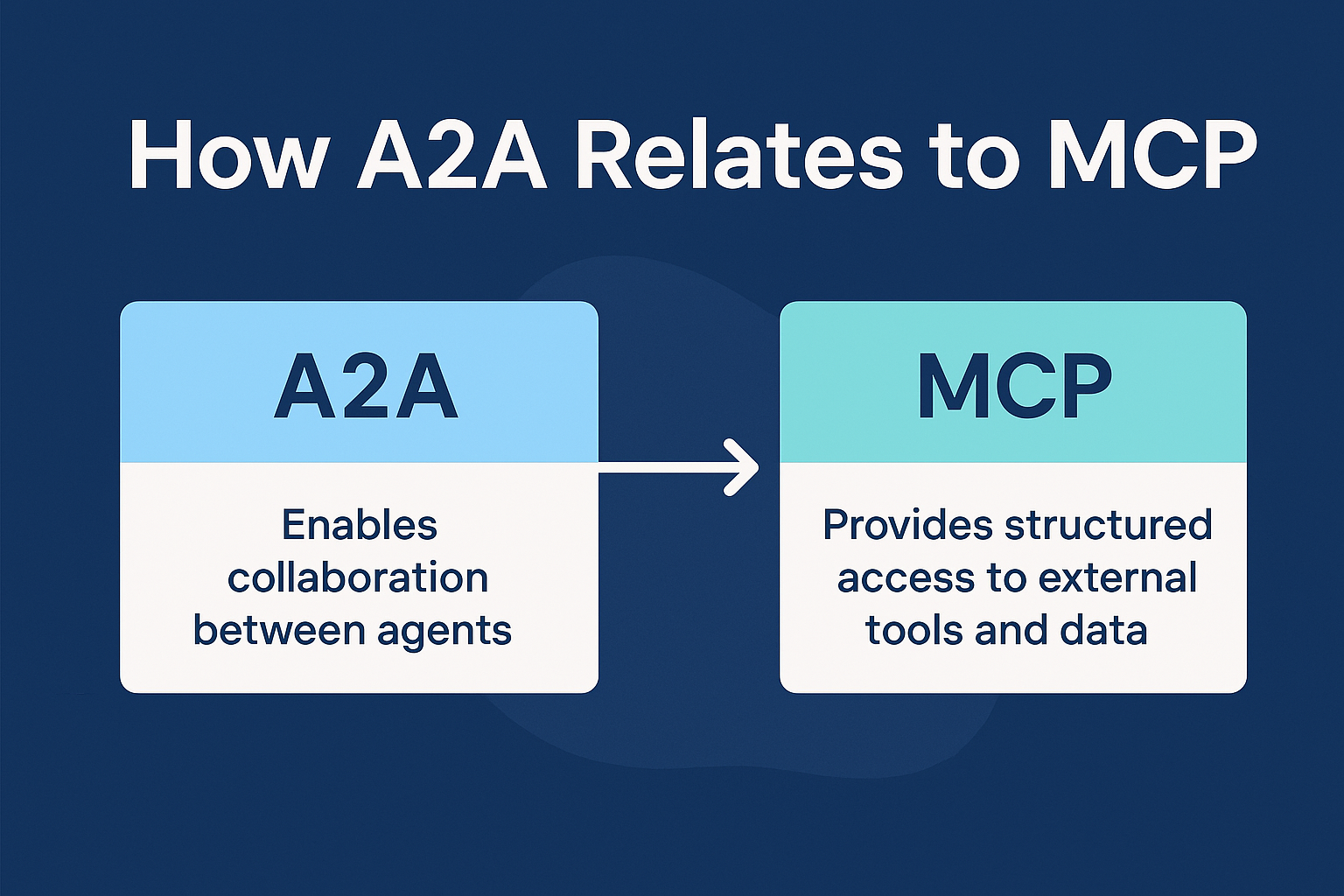As artificial intelligence continues to evolve and become more integrated into our daily workflows, a dual focus on internal agent communication and secure external integration is essential. In this blog post, we’ll explore Agent-to-Agent (A2A) and the Model Context Protocol (MCP), two complementary standards that collectively underpin the emerging “AI agent stack.” We’ll examine how A2A and MCP function separately, why their roles are distinct yet interdependent, and how their synergy creates robust multi-agent systems.
Understanding the Distinct Roles
What is Agent-to-Agent (A2A)?
Agent-to-Agent (A2A) is designed to enable seamless communication and collaboration among multiple AI agents. Think of it as the internal communication network within an AI ecosystem. A2A’s primary focus includes:
- Task Sharing: Agents delegate tasks amongst themselves.
- Decision-Making: Multiple agents contribute to informed decision-making processes.
- Coordination: Agents coordinate their actions in a decentralized manner, ensuring that each part of the system works in harmony.
In environments where tasks are complex and require multi-step processes, A2A ensures that each agent can effectively contribute to overall system performance.
What is the Model Context Protocol (MCP)?
In contrast, the Model Context Protocol (MCP) serves as a standardized framework that connects AI models to external tools, data sources, and systems. MCP’s primary roles include:
- Securing Access: Ensuring that agents have safe and controlled access to external resources.
- Data Integration: Allowing agents to retrieve relevant information from APIs, databases, or other external tools.
- Enhanced Functionality: By leveraging external data and tools, agents can perform more complex tasks than they would be able to do in isolation.
Essentially, MCP acts as the bridge between your internal AI collaboration framework and the external environment, ensuring that AI agents remain informed and functional.
A Complementary Approach: Integrating A2A with MCP
Rather than viewing A2A and MCP as competing protocols, it’s beneficial to see them as building blocks that work together:
- Layered Functionality:
A2A and MCP cater to two different layers of the AI ecosystem. A2A is about internal harmony and collaboration among agents, whereas MCP focuses on integrating these agents with external systems. - Enhanced Decision-Making:
Consider a scenario where multiple agents are working together on a complex problem. Through A2A, these agents can discuss and strategize. At the same time, MCP empowers them with external data, so their decisions are both informed and contextually relevant. - Robust Ecosystem:
This layered approach not only enhances collaboration but also strengthens the overall system architecture. By separating internal communication from external integration, organizations can build secure, scalable, and resilient AI systems.
Practical Use Cases
Enterprise Applications
In an enterprise setting, the dual use of A2A and MCP can be transformational. Imagine a workflow where:
- Task Delegation: Multiple agents manage and delegate tasks such as scheduling meetings, resource allocation, and other administrative tasks.
- Real-Time Data Access: While collaborating internally via A2A, these agents use MCP to fetch real-time information from external APIs or corporate databases. For example, consider a hiring workflow scenario where:
- A2A Coordination: Several agents collaborate on sourcing, interviewing, and scheduling candidates.
- MCP Integration: Simultaneously, these agents access external HR databases to retrieve candidate profiles and other relevant information.
This scenario highlights how A2A and MCP work together to optimize processes, improve decision-making, and enhance overall productivity.
Strategic Industry Partnerships
The collaboration between Google and Anthropic, as seen in the development of A2A and MCP, demonstrates a strategic alignment that benefits both enterprises and developers. Google’s focus on enterprise security, compliance, and governance pairs well with Anthropic’s developer-driven approach to reducing integration fragmentation. This partnership ensures:
- Compliance and Security:
Enterprises can adopt both protocols with confidence, knowing that security and compliance are at the forefront of system design. - Innovation and Flexibility:
Developers gain access to open standards that foster innovation and allow for rapid integration of new functionalities.
Conclusion
To encapsulate, A2A and MCP address distinct yet complementary challenges in the AI ecosystem:
- A2A focuses on enabling seamlewss, secure collaboration among AI agents, allowing them to handle complex, distributed tasks effectively.
- MCP provides a structured, secure framework for connecting these agents with external tools and data, ensuring that internal operations are well-informed and adaptable.
By integrating these two standards, organizations are well-equipped to build intelligent, collaborative multi-agent systems that are both innovative and secure. This “AI agent stack” is paving the way for the next generation of enterprise-grade AI solutions, where internal coordination and external integration work in concert to drive unprecedented levels of efficiency and innovation.
#A2A #MCP #AIIntegration #MultiAgentSystems #AIProtocols #FusionAILabs #EnterpriseAI #AIInnovation #AgentCommunication #FutureOfAI






Leave a comment